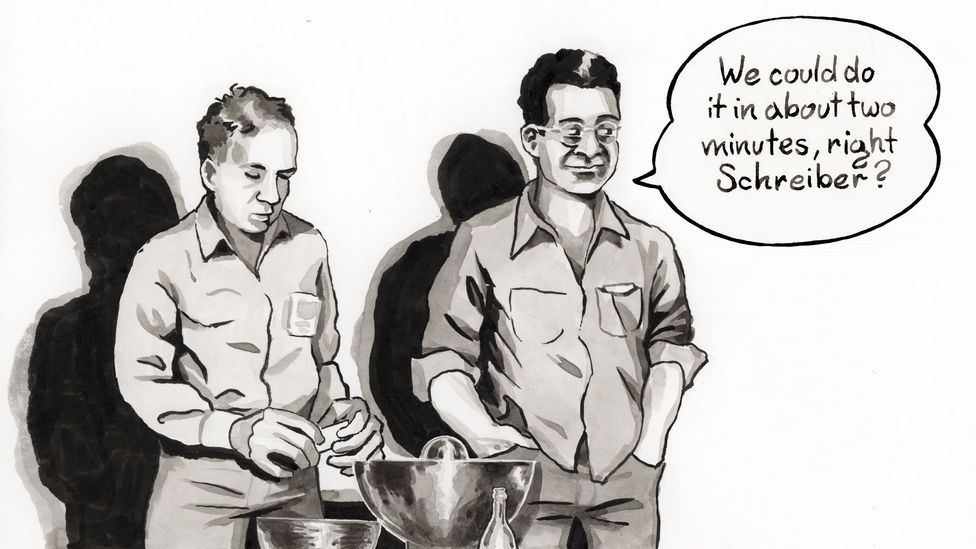Less than a year after the Trinity atomic bomb test, a careless slip with a screwdriver cost Louis Slotin his life.
In 1946, Slotin, a nuclear physicist, was poised to leave his job at Los Alamos National Laboratories (formerly the Manhattan Project). When his successor came to visit his lab, he decided to demonstrate a potentially dangerous apparatus, called the “critical assembly”. During the demo, he used his screwdriver to support a beryllium hemisphere over a plutonium core. It slipped, and the hemisphere dropped over the core, triggering a burst of radiation. He died nine days later.
Last week, BBC Future explored the consequences of this fatal accident in a specially illustrated story created by the artist and writer Ben Platts-Mills:
- The Blue Flash: How a careless slip led to a fatal accident in the Manhattan Project
In this gallery, Platts-Mills explains how he composed the illustrations, based on reconstructions created shortly after the accident, archive photographs, and his own mock-up of the apparatus built from household materials.
In 1948, two years after the criticality accident that killed Louis Slotin, researchers reconstructed the laboratory contents and layout (Credit: Alamy)

The goal was a scientific examination of the accident. Physicist Chris Wright posed with the reconstructed “critical assembly” (Credit: Alamy)

I had been researching the Slotin accident for months, thinking about how I would describe it. These photographs would prove invaluable (Credit: Alamy)

…as would other photos like this extraordinary shot of Edward Wilder riding the “Fat Man” bomb in 1945, provided by his son Marshall (Credit: Marshall Wilder/Ben Platts-Mills)

As I began drawing from the photographs, I realised that there were objects in them that were unfamiliar to me and that might confuse a general reader (Credit Ben Platts-Mills)

For example, I wasn’t sure what this device was, until a friend suggested that it’s a signal amplifier, drawing a signal from a detector on (or under) the table (Credit: Alamy)

I would have to strike a balance between making my drawings scientifically and historically accurate and telling the story in a clear, accessible way (Credit: Ben Platts-Mills)

To help me compose the illustrations, I experimented by posing with household items – but this only took me so far (Credit: Ben Platts-Mills)

So, I decided to build my own critical assembly, using mixing bowls, cardboard – and a spray-painted foam ball for the plutonium core (Credit: Ben Platts-Mills)

This reconstruction would allow me to capture scenes from alternative angles, with the right textures and lighting (Credit: Ben Platts-Mills)

My friend Andy Sewell took a set of photographs of me posing with the assembly (Credit: Andy Sewell)

I then drew from these photos to show Slotin demonstrating the assembly with his screwdriver (Credit: Ben Platts-Mills)

The reconstruction allowed me to compose particular angles that weren’t present in the archive photographs (Credit: Andy Sewell)

I drew from a combination of Andy’s photos and archival ones to create the final artwork (Credit: Ben-Platts Mills)

The final illustration of Slotin, based on a combination of my body, the mock-up assembly, and his face from an old photograph (Credit: Ben Platts-Mills)

For the dialogue, I drew from primary sources. In this instance, I paraphrased a quote from Raemer Schreiber’s official report on
the accident (Credit: Ben Platts-Mills)

I used this diagram from an internal report on the accident to help me position the people in my drawings. My research suggested it was based on a sketch by Slotin (Credit: LANL)

We created this important shot of the radiation burst using a light placed beneath the mock-up (Credit: Andy Sewell)

Together, these techniques allowed me to create new images of important moments that were in keeping with the era but not available in the archive (Credit: Ben Platts-Mills)
Thank to the following people who helped along the way: Andy Sewell, Marshall Wilder, Richard Fisher, Nicola Stephanie, Glenn Adamson, Tony Hall, Sam Winston, Allex Wellerstein, Christina Petrie, Roger Sherman, Javier Hirschfeld, Joe Rizzo Naudi, Annie Hayter, Tiiu Mortley, Eleanor Nairne, Claire Crofton, Sasha Galitzine, Kirsten Duran, and Los Alamos National Laboratories.
*Ben Platts-Mills is a writer and artist whose work investigates power, reasoning and vulnerability, and the ways science is represented in popular culture. His memoir, Tell Me The Planets, was published in 2018. On Instagram he is @benplattsmills.
—
Join one million Future fans by liking us on Facebook, or follow us on Twitter or Instagram.
If you liked this story, sign up for the weekly bbc.com features newsletter, called “The Essential List” – a handpicked selection of stories from BBC Future, Culture, Worklife, Travel and Reel delivered to your inbox every Friday.
